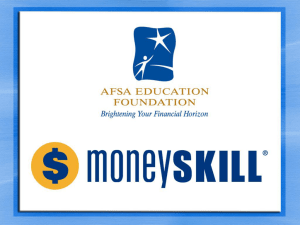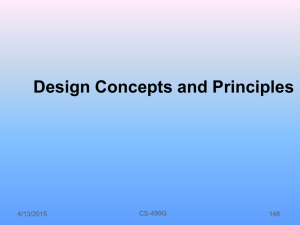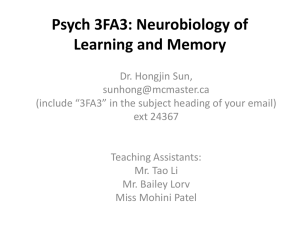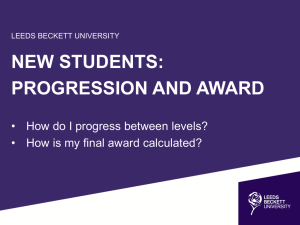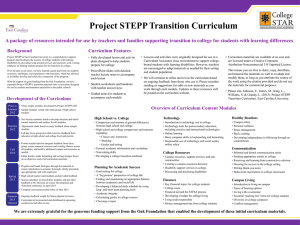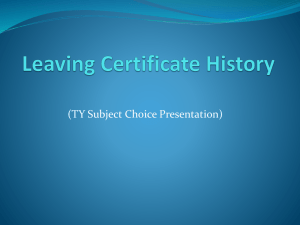Cost and Logistics of Implementing a Tissue
advertisement
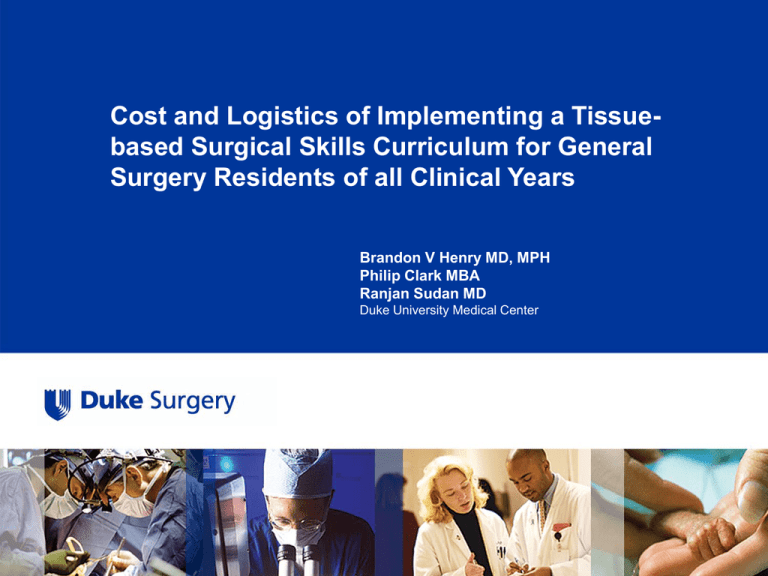
Cost and Logistics of Implementing a Tissuebased Surgical Skills Curriculum for General Surgery Residents of all Clinical Years Brandon V Henry MD, MPH Philip Clark MBA Ranjan Sudan MD Duke University Medical Center • No financial conflicts to disclose Background • In 2007, ACS and APDS jointly released the Surgical Skills Curriculum for Residents in response to a need for a standardized technical skills training curriculum. • Three Phases – Phase 1: Basic Skills (20 modules) – Phase 2: Advanced Procedures (15 modules) – Phase 3: Team-Based Training (10 modules) • Wide-spread adoption across institutions and different levels of residency training has been limited. *Scott DJ, Dunnington DL. J Gastrointest Surg 2008; 12:213-221 Existing Literature • Rooney et al. implemented 13 modules over 20 weeks for 14 PGY-1 residents • Danzer et al. implemented 32 modules over 4 weeks for 38 PGY-1and -2 residents • Primarily Phase 1 modules • Minimal tissue-based modules *Rooney D, et al. Surgery 2010; 147(5): 614-621 **Danzer E, et al. Journal of Surgical Education 2011; 68(6): 519-525. Objective • To determine the costs and administrative logistics associated with a residency-wide implementation of the ACS/APDS Surgical Skills Curriculum Methods… • Performed a needs assessment survey of residents and faculty – Strongly desired more tissue-based simulation • Assembled the Curriculum Steering Committee – Program leadership, key faculty, resident representatives • Obtained departmental financial support • Recruited faculty according to area of expertise • Protected simulation activity time Methods • Created a 36 Module final curriculum – 7 animal tissue lab sessions – 11 cadaveric lab sessions – 18 dry simulation lab sessions • Organized in graduated fashion – Basic/Dry-sim modules for juniors • Ex: Knot tying/suturing, Central Lines, Urinary Catheterization – Complex/Tissue labs for seniors • Ex: Lap Sigmoidectomy, Lap Nissen, Gastric Resection • Implementation supported by simulation center administrative staff • Costs and logistical notes were tracked Dry Simulation Modules Table 3. Cost of Dry Simulation Modules (in dollars)* ACS Phase 1 1 1 1 1 1 1 1 1 1 1, 3 2 2 2 2 3 3 Module Knot Tying/Suturing Urethral and Suprapubic Catheterization Airway Management Chest Tube and Thoracentesis Central Line Insertion/Monitoring and Arterial Lines Vascular Anastomosis Laparotomy Open and Closure Colonoscopy Stapled Gastrointestinal Anastomosis Basic Laparoscopy Skills Advanced Laparoscopy/Laparoscopic Crisis Laparoscopic Ventral Hernia Repair Open/Lap Common Bile Duct Exploration Appendectomy Laparoscopic Appendectomy Open TT: Trauma Team Training TT: Patient Handoff/Preop Briefing and Checklists Facility Equipment/ Simulator Overhead Materials Estimated Total Module Simulator Cost† Cost‡ Cost Teaching Cost Cost --462 1400 613 2,475 Trauma Man 3 462 487 613 1,565 Trauma Man 35 462 875 613 1,985 SimMan, TraumaMan 157 462 -613 1,232 Central Line Man 238 462 435 613 1,748 --462 1050 613 2,125 -86 462 231 613 1,392 Immersion VR 247 462 -613 1,322 --462 364 613 1,439 Trauma Man 123 462 -613 1,198 -123 462 -613 1,198 Lap VR Mentor 70 462 -613 1,145 -196 462 529 613 1,800 -123 462 385 613 1,583 -123 462 385 613 1,583 SimMan 3G 123 462 -613 1,198 SimMan 291 462 613 1,366 TOTAL 1,938 7,854 6,141 * Donated or shared equipment instruments and disposable materials not calculated into cost † Estimated as hourly cost derived from total cost amortized over 5 years (assuming 8hr ave weekly usage) ‡ Includes human resource costs. Calculated from annual overhead of $320,000 10,421 26,354 Animal Tissue Modules Table 4. Cost of Animal Tissue Modules (in dollars) ACS Phase 1 1 1 2 2 2 2 Module Surgical Biopsy† Upper Endoscopy† Hand Sewn Gastrointestinal Anastomosis† Laparoscopic Colon Resection‡ Laparoscopic Sigmoid Resection‡ Open Colon Resection‡ Laparoscopic Nissen‡ Specimen Cost 170 170 170 608 608 608 608 Facility Use Fee* 190 190 190 1,001 1,001 1,001 1,001 Equipment Cost** -87 ------ Estimated Teaching Cost 613 613 613 613 613 613 613 TOTAL 2,942 4,574 87 4,291 * Instruments and disposable materials cost covered in Vivarium facility use fees (not itemized) ** Donated/loaned equipment not calculated in total cost) † Explant material module ‡ Live porcine module Total Module Cost 973 1,060 973 2,222 2,222 2,222 2,222 11,894 Human Fresh Tissue Modules • Cost per lab largely constant – Flat $300 fee per module for space and equipment – Specimens cost $2,000-6,000 per module • Total for 11 Modules: $72,050 – Specimens: $62,000 – Facility Use Fees: $3,300 – Approx. $6,750 in estimated teaching time Total Cost • 36 Modules • $111,240 total – Approx. $3,200 per resident (n=35) • $22,075 in faculty teaching – 111 hours Comparing Fidelities Dry Simulation Animal Tissue Human Fresh Tissue Annual Cost: $26,354 $11,890 $72,050 Per Resident Per Module: $220 $240 $940 Pros: Ease of reproduction No ethical problems Live Specimens Anatomical accuracy Lower fidelity Capital simulator costs Anatomy Regulatory barriers Ethics of animal use Expensive Specimen quality issues Cons: Comparison to Previous Reports Rooney, et al* Danzer, et al** • 14 PGY1 residents • 38 PGY1, PGY2 • 32 Modules • 13 Modules • High-end budget: • Annual budget: $476,000 $187,200 – $13,400 per resident • Low-end budget: $21,500 – $12,500 per resident Henry, et al • 35 PGY1-5 • 36 Modules • Annual budget: $111,240 – $3,200 per resident • No low-end budget • No low-end budget – $1,540 per resident • No estimation of teaching cost *Rooney D, et al. Surgery 2010; 147(5): 614-621 • $30,000 in faculty payment • $22,075 estimated faculty time **Danzer E, et al. Journal of Surgical Education 2011; 68(6): 519-525. Conclusions • ACS/APDS Skills curriculum with a significant tissue-based component is feasible for programs with appropriate infrastructure • The curriculum is costly and small institutions may need to form regional partnerships in order to access necessary resources • Animal modules may be the most costeffective method of delivering high-fidelity tissue-based training Thank You
